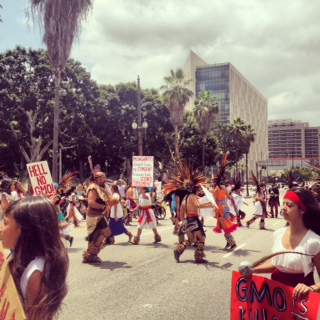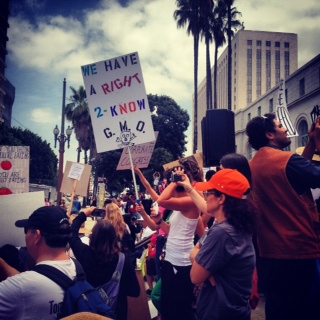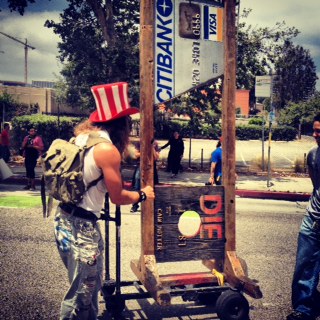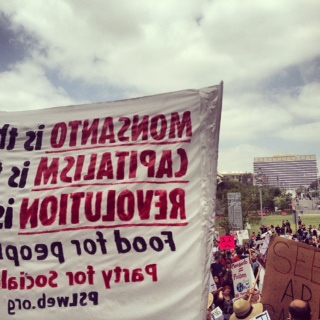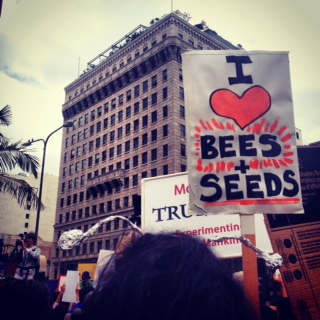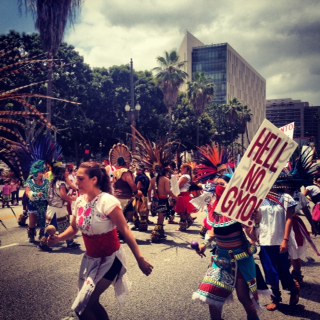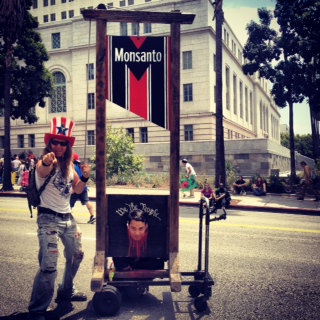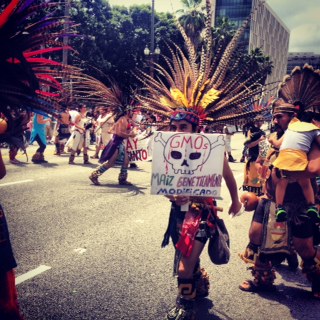 This morning I attended Los Angeles’s March Against Monsanto, marching with thousands of others who are trying to Ban GMO’s in LA & save the future of our food. We are currently 36 countries strong, totaling events in over 250 cities! I will share with you Ten Shockingly True Facts about Monsanto – the inventors of Agent Orange, and “Market Leaders” in Genetically Modified crops, who have been largely responsible for contaminating the global food chain.
This morning I attended Los Angeles’s March Against Monsanto, marching with thousands of others who are trying to Ban GMO’s in LA & save the future of our food. We are currently 36 countries strong, totaling events in over 250 cities! I will share with you Ten Shockingly True Facts about Monsanto – the inventors of Agent Orange, and “Market Leaders” in Genetically Modified crops, who have been largely responsible for contaminating the global food chain.
1. The 2009 Antitrust Investigation
In 2009, Monsanto came under scrutiny from the U.S. Department of Justice, which began investigating whether the company’s activities in the soybean markets were breaking anti-trust rules. In 2010, the Department of Justice created a website through which comments on “Agriculture and Antitrust Enforcement Issues in Our 21st Century Economy” could be submitted; over 15,000 comments were submitted including a letter by 14 State Attorneys General. The comments are publicly available.
On November 16, 2012, Monsanto announced that it had received written notification from the U.S. Department of Justice that the Antitrust Division had concluded its inquiry and that the Department of Justice had closed the inquiry without taking any enforcement action. Opponents of Monsanto’s seed patenting and licensing practices expressed frustration that the Department of Justice released no information about the results of the inquiry.
2. In India, Monstanto’s seed production is done mostly through child labor—it is carried out on plots owned by small farmers, who sell the seed to “seed organizers”, who in turn sell the seed to public and private seed agencies and companies. The public and private agencies and companies include Indian state corporations, Mahyco-Monsanto, Syngenta, and others. Monsanto’s website states that the company complies with all child labor laws and that they are working towards minimizing its occurrence.
3. In the late 1990s and early 2000s, public attention was drawn to suicides by indebted farmers in India following crop failures.
Critics, including Vandana Shiva, said that the crop failures could “often be traced to” Monsanto’s Bt cotton, and that the seeds increased farmers’ indebtedness, and argued that Monsanto misrepresented the profitability of their genetically modified cotton, Bt Cotton, causing farmers to suffer losses leading to debt. In 2009, Ms. Shiva wrote that Indian farmers who had previously spent as little as 7 rupees per kilogram were now paying up to Rs. 17,000 per kilo per year after switching to BT cotton. More recently, in 2012 the Indian Council of Agricultural Research (ICAR) and the Central Cotton Research Institute (CCRI) stated that for the first time farmer suicides could be linked to a decline in the performance of Bt cotton, and they issued an advisory stating that “cotton farmers are in a deep crisis since shifting to Bt cotton. The spate of farmer suicides in 2011-12 has been particularly severe among Bt cotton farmers.
4. In 1996, the New York Times reported that: “Dennis C. Vacco, the Attorney General of New York, ordered the company to pull ads that said Roundup was “safer than table salt” and “practically nontoxic” to mammals, birds and fish. The company withdrew the spots, but also said that the phrase in question was permissible under E.P.A. guidelines.”
In 1999, Monsanto was condemned by the UK Advertising Standards Authority (ASA) for making “confusing, misleading, unproven and wrong” claims about its products over the course of a £1 million advertising campaign. The ASA ruled that Monsanto had presented its opinions “as accepted fact” and had published “wrong” and “unproven” scientific claims. Monsanto responded with an apology and claimed it was not intending to deceive and instead “did not take sufficiently into account the difference in culture between the UK and the USA in the way some of this information was presented.”
5. Monsanto lobbies the United States Congress and the U.S. Department of Agriculture about regulations that would affect the production and distribution of genetically engineered produce. In 2011, Monsanto spent about $6.3 million. In comparison, the US Chamber of Commerce spent the most in lobbying in 2011, with $66.4 million, and the 20th highest spender, Pfizer, spent $12.9 million. US diplomats in Europe have worked directly for Monsanto. In 2008, Monsanto spent $8.8 million for lobbying. $1.5 million was to outside lobbying firms with the remainder used by in-house lobbyists. In 2011, total money spent on lobbying was about $6.3 million, more than any other agribusiness firm except the tobacco company Altria, and $2 million of which was spent on matters concerning “Foreign Agriculture Biotechnology Laws, Regulations, and Trade.”
6. Genetic use restriction technology, colloquially known as “terminator technology”, produces plants that have sterile seeds. If put into use, it would prevent the spread of those seeds into the wild. It also would prevent farmers from planting seeds they harvest, requiring them to repurchase seed for every planting, although they also need to do this for hybrid seeds, because second-generation seeds are inferior, and in cases of patented transgenic seeds, where patent-holders like Monsanto enter into contracts with farmers who agree not to plant harvested seeds as a condition of purchase.
Terminator technology has been developed by governmental labs, university researchers, and companies, sometimes in collaboration and sometimes independently. The technology has never been known to have been used commercially. Rumors that Monsanto and other companies intended to introduce terminator technology have caused protests, for example in India.
In 1999, Monsanto pledged not to commercialize terminator technology, and has kept that pledge on its website to the present day.The Delta and Pine Land Company intended to commercialize the technology, but D&PL was acquired by Monsanto in 2007.
7. Until it stopped production in 1977, Monsanto was the source of 99% of the polychlorinated biphenyls (PCBs) used by U.S. industry. The PCBs were sold under trade names such as Aroclor and Santotherm; the name Santotherm is still used for non-cholorinated products. PCBs are a persistent organic pollutant, and cause cancer in animals and likely in humans as well, among other health effects; PCBs were initially widely welcomed due to the electrical industry’s need for durable, safer (than flammable mineral oil) cooling and insulating fluid for industrial transformers and capacitors. PCBs were also commonly used as stabilizing additives in the manufacture of flexible PVC coatings for electrical wiring, and in electronic components to enhance the heat and fire resistance of the PVC. They were known to be highly toxic from the beginning, but it was assumed that they would be contained in the products in which they were used. However, as leaks of transformers occurred, and toxicity problems arose near factories, their durability and toxicity became widely recognized as serious problems. PCB production was banned by the U.S. Congress in 1979 and by the Stockholm Convention on Persistent Organic Pollutants in 2001.
8. As of 2009, the overall Roundup line of products including the GM seeds represented about 50% of Monsanto’s business. The patent on the first type of Roundup Ready crop that Monsanto produced (soybeans) expires in 2014.
Monsanto has broadly licensed the patent to other seed companies that include the glyphosate resistance trait in their seed products.
About 150 companies have licensed the technology, including Syngenta[75] and Dupont/Pioneer.
In addition, Monsanto invented and sells agricultural seeds that are genetically modified to make a crystalline insecticidal protein from Bacillus thuringiensis, known as Bt. In 1995 Monsanto's potato plants producing Bt toxin were approved for sale by the Environmental Protection Agency, after having approved by the U.S. FDA, making it the first pesticide-producing crop to be approved in the United States.[77] Monsanto has subsequently developed Bt maize (MON 802, MON 809, MON 863, MON 810), Bt soybean,[78] and Bt cotton.
9. Monsanto scientists became the first to genetically modify a plant cell in 1982. Five years later, Monsanto conducted the first field tests of genetically engineered crops.
In 1985, Monsanto acquired G. D. Searle & Company, a life sciences company focusing on pharmaceuticals, agriculture, and animal health. In 1993, Monsanto’s Searle division filed a patent application for Celebrex, which in 1998 became the first selective COX‑2 inhibitor to be approved by the U.S. Food and Drug Administration (FDA) Celebrex was taken off the market twice and lobbied by Monsanto’s people to be re-released. It was approved both times.
Celebrex became a blockbuster drug and was often mentioned as a key reason for Pfizer's acquisition of Monsanto's pharmaceutical business in 2002.
10. 1987: Monsanto is one of the companies named in an $180 million settlement for Vietnam War veterans exposed to Agent Orange. In the 1960s and 1970s, Monsanto was also one of the most important producers of Agent Orange for United States Armed Forces operations in Vietnam. Vietnam estimates 400,000 people were killed or maimed, and 500,000 children born with birth defects as a result of its use. The Red Cross of Vietnam estimates that up to 1 million people are disabled or have health problems due to Agent Orange.
Join us Here, and Fight For Your Food!
Q MANAGEMENT | FACEBOOK | PHOTOGRAPHY | LOOKBOOK | TUMBLR
Love & Light
ૐ



